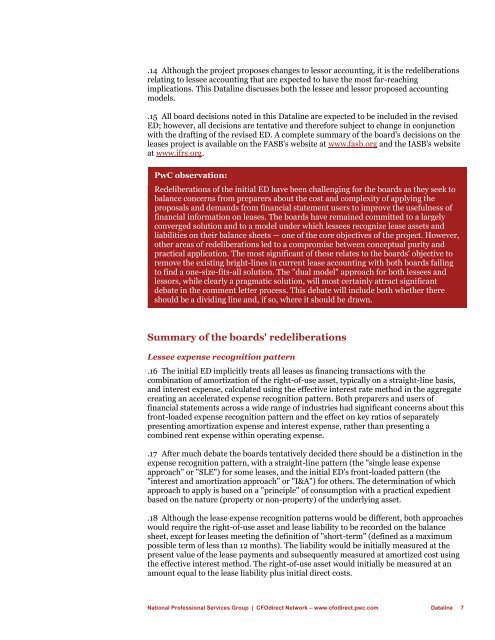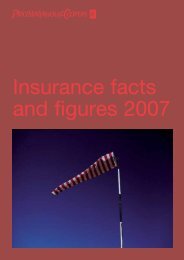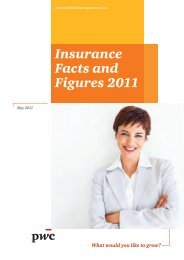Dataline A look at current financial reporting issues - PwC
Dataline A look at current financial reporting issues - PwC
Dataline A look at current financial reporting issues - PwC
You also want an ePaper? Increase the reach of your titles
YUMPU automatically turns print PDFs into web optimized ePapers that Google loves.
.14 Although the project proposes changes to lessor accounting, it is the redeliber<strong>at</strong>ions<br />
rel<strong>at</strong>ing to lessee accounting th<strong>at</strong> are expected to have the most far-reaching<br />
implic<strong>at</strong>ions. This <strong>D<strong>at</strong>aline</strong> discusses both the lessee and lessor proposed accounting<br />
models.<br />
.15 All board decisions noted in this <strong>D<strong>at</strong>aline</strong> are expected to be included in the revised<br />
ED; however, all decisions are tent<strong>at</strong>ive and therefore subject to change in conjunction<br />
with the drafting of the revised ED. A complete summary of the board's decisions on the<br />
leases project is available on the FASB's website <strong>at</strong> www.fasb.org and the IASB's website<br />
<strong>at</strong> www.ifrs.org.<br />
<strong>PwC</strong> observ<strong>at</strong>ion:<br />
Redeliber<strong>at</strong>ions of the initial ED have been challenging for the boards as they seek to<br />
balance concerns from preparers about the cost and complexity of applying the<br />
proposals and demands from <strong>financial</strong> st<strong>at</strong>ement users to improve the usefulness of<br />
<strong>financial</strong> inform<strong>at</strong>ion on leases. The boards have remained committed to a largely<br />
converged solution and to a model under which lessees recognize lease assets and<br />
liabilities on their balance sheets — one of the core objectives of the project. However,<br />
other areas of redeliber<strong>at</strong>ions led to a compromise between conceptual purity and<br />
practical applic<strong>at</strong>ion. The most significant of these rel<strong>at</strong>es to the boards' objective to<br />
remove the existing bright-lines in <strong>current</strong> lease accounting with both boards failing<br />
to find a one-size-fits-all solution. The "dual model" approach for both lessees and<br />
lessors, while clearly a pragm<strong>at</strong>ic solution, will most certainly <strong>at</strong>tract significant<br />
deb<strong>at</strong>e in the comment letter process. This deb<strong>at</strong>e will include both whether there<br />
should be a dividing line and, if so, where it should be drawn.<br />
Summary of the boards' redeliber<strong>at</strong>ions<br />
Lessee expense recognition p<strong>at</strong>tern<br />
.16 The initial ED implicitly tre<strong>at</strong>s all leases as financing transactions with the<br />
combin<strong>at</strong>ion of amortiz<strong>at</strong>ion of the right-of-use asset, typically on a straight-line basis,<br />
and interest expense, calcul<strong>at</strong>ed using the effective interest r<strong>at</strong>e method in the aggreg<strong>at</strong>e<br />
cre<strong>at</strong>ing an acceler<strong>at</strong>ed expense recognition p<strong>at</strong>tern. Both preparers and users of<br />
<strong>financial</strong> st<strong>at</strong>ements across a wide range of industries had significant concerns about this<br />
front-loaded expense recognition p<strong>at</strong>tern and the effect on key r<strong>at</strong>ios of separ<strong>at</strong>ely<br />
presenting amortiz<strong>at</strong>ion expense and interest expense, r<strong>at</strong>her than presenting a<br />
combined rent expense within oper<strong>at</strong>ing expense.<br />
.17 After much deb<strong>at</strong>e the boards tent<strong>at</strong>ively decided there should be a distinction in the<br />
expense recognition p<strong>at</strong>tern, with a straight-line p<strong>at</strong>tern (the "single lease expense<br />
approach" or "SLE") for some leases, and the initial ED's front-loaded p<strong>at</strong>tern (the<br />
"interest and amortiz<strong>at</strong>ion approach" or "I&A") for others. The determin<strong>at</strong>ion of which<br />
approach to apply is based on a "principle" of consumption with a practical expedient<br />
based on the n<strong>at</strong>ure (property or non-property) of the underlying asset.<br />
.18 Although the lease expense recognition p<strong>at</strong>terns would be different, both approaches<br />
would require the right-of-use asset and lease liability to be recorded on the balance<br />
sheet, except for leases meeting the definition of "short-term" (defined as a maximum<br />
possible term of less than 12 months). The liability would be initially measured <strong>at</strong> the<br />
present value of the lease payments and subsequently measured <strong>at</strong> amortized cost using<br />
the effective interest method. The right-of-use asset would initially be measured <strong>at</strong> an<br />
amount equal to the lease liability plus initial direct costs.<br />
N<strong>at</strong>ional Professional Services Group | CFOdirect Network – www.cfodirect.pwc.com <strong>D<strong>at</strong>aline</strong> 7

















